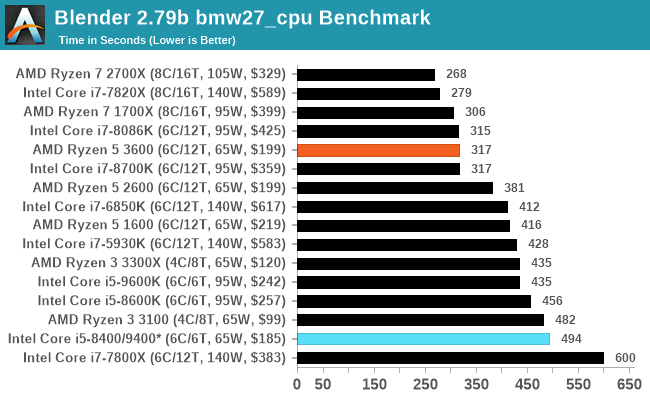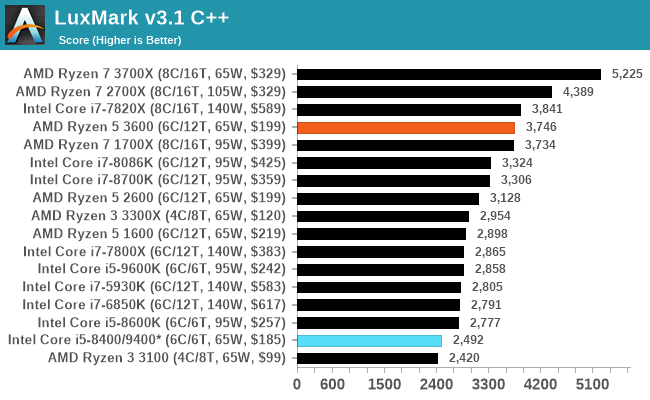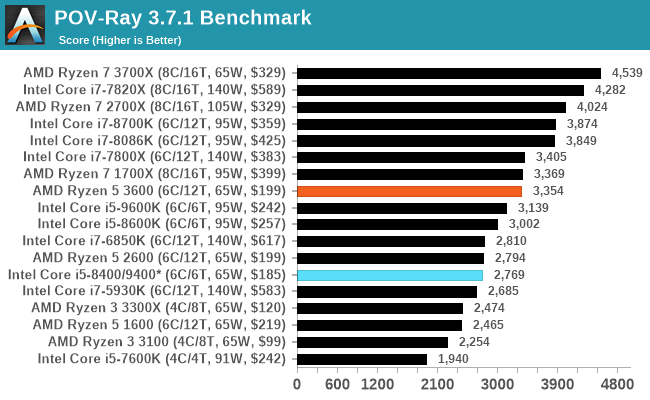AMD Ryzen 5 3600 Review: Why Is This Amazon's Best Selling CPU?
by Dr. Ian Cutress on May 18, 2020 9:00 AM ESTCPU Performance: Rendering Tests
Rendering is often a key target for processor workloads, lending itself to a professional environment. It comes in different formats as well, from 3D rendering through rasterization, such as games, or by ray tracing, and invokes the ability of the software to manage meshes, textures, collisions, aliasing, physics (in animations), and discarding unnecessary work. Most renderers offer CPU code paths, while a few use GPUs and select environments use FPGAs or dedicated ASICs. For big studios however, CPUs are still the hardware of choice.
All of our benchmark results can also be found in our benchmark engine, Bench.
Corona 1.3: Performance Render
An advanced performance based renderer for software such as 3ds Max and Cinema 4D, the Corona benchmark renders a generated scene as a standard under its 1.3 software version. Normally the GUI implementation of the benchmark shows the scene being built, and allows the user to upload the result as a ‘time to complete’.
We got in contact with the developer who gave us a command line version of the benchmark that does a direct output of results. Rather than reporting time, we report the average number of rays per second across six runs, as the performance scaling of a result per unit time is typically visually easier to understand.
The Corona benchmark website can be found at https://corona-renderer.com/benchmark

Blender 2.79b: 3D Creation Suite
A high profile rendering tool, Blender is open-source allowing for massive amounts of configurability, and is used by a number of high-profile animation studios worldwide. The organization recently released a Blender benchmark package, a couple of weeks after we had narrowed our Blender test for our new suite, however their test can take over an hour. For our results, we run one of the sub-tests in that suite through the command line - a standard ‘bmw27’ scene in CPU only mode, and measure the time to complete the render.
Blender can be downloaded at https://www.blender.org/download/

LuxMark v3.1: LuxRender via Different Code Paths
As stated at the top, there are many different ways to process rendering data: CPU, GPU, Accelerator, and others. On top of that, there are many frameworks and APIs in which to program, depending on how the software will be used. LuxMark, a benchmark developed using the LuxRender engine, offers several different scenes and APIs.
In our test, we run the simple ‘Ball’ scene on both the C++ and OpenCL code paths, but in CPU mode. This scene starts with a rough render and slowly improves the quality over two minutes, giving a final result in what is essentially an average ‘kilorays per second’.

POV-Ray 3.7.1: Ray Tracing
The Persistence of Vision ray tracing engine is another well-known benchmarking tool, which was in a state of relative hibernation until AMD released its Zen processors, to which suddenly both Intel and AMD were submitting code to the main branch of the open source project. For our test, we use the built-in benchmark for all-cores, called from the command line.
POV-Ray can be downloaded from http://www.povray.org/












114 Comments
View All Comments
eastcoast_pete - Monday, May 18, 2020 - link
Thanks Ian!While this is not important for many (most?) readers here, I would like to see AMD or anyone else putting a more basic GPU (under $ 50 retail) out that has HDMI 2.0a or better, display port out, and that has ASICs for x264/265 and VP9 decoding; AV1 would be a plus. This could be a PCIe dGPU or something directly soldered into a MB. Am I the only one who's find that interesting? I don't like to always have to plug a high-powered dGPU into each build that has more than just an entry level CPU, so this would help.
Spunjji - Tuesday, May 19, 2020 - link
You'll likely be waiting a while. You'd need to wait for the next generation of GPUs with new display controllers and video decoders. There's a rumour that Nvidia will be producing an Ampere "MX550" for mobile, which could mean a dGPU based on the same chip being released for ~$100. Give that a couple more years to drop in price and, well, by then you'll probably want new standards. :DPgndu - Monday, May 18, 2020 - link
I come here for a clearer perspective more than benchmarks, but the timing of this article is weird, especially since 10th Gen's at the door. I get the market or Atleast pc builder cause and effect but market just got blown out of proportions with options, what actually transfers to general populace is not clear until OEM's embrace the reality like nividiaArbie - Monday, May 18, 2020 - link
"The Core i5-10500 ... is 65 W, the same as AMD".Anandtech knows very well that Intel TDP is not the same as AMD TDP. Please stop falling into the noob-journo trap of simply repeating the Intel BS just because it's official BS.
GreenReaper - Monday, May 18, 2020 - link
In fairness, TMD is also turboing to 88W, with cores plus uncore measured as taking significantly more than 65W.Spunjji - Tuesday, May 19, 2020 - link
Absolutely right, but also in fairness, Intel's sole enhancement for the 10 series appears to be enabling higher clock speeds - and they're made on the same process with the same architecture as the 9 series, which inevitably means more power will be required to reach those higher clocks.So, it's likely to be either a CPU with similar real power use to the AMD processor that never really hits its rated turbo clocks, or a CPU that does hit its rated turbo and never drops below ~100W under sustained load. It's likely to be power and speed competitive on an either/or basis, but not both at the same time.
watzupken - Tuesday, May 19, 2020 - link
This is true that its going above its TDP to provide the boost speed. However this is a practice that Intel has practiced since its Kaby Lake/ Coffee Lake series. Unfortunately, they are the worst violator when it comes to exceeding the supposed TDP when you consider how much power it is pulling to sustain its boost (PL2) speed. If you consider the boost speed of the Comet Lake, even the supposed 65W i5 10xxx series is not going to keep to 65W given the boost speed of up to 4.8Ghz, though nothing is mentioned about the all core turbo, but should be somewhere close, i.e. 4.2 to 4.6Ghz is my guess.lakedude - Monday, May 18, 2020 - link
I assume no one has mentioned the typo since it is still there."Competition
With six cores and twelve threads, the comparative Intel options vary between something like the Core i7-9600KF with six cores and no hyperthreading..."
Gotta be i5, right?
Kalelovil - Tuesday, May 19, 2020 - link
@Ian CutressThere appears to be a mistake in the AI Benchmark results, the Ryzen 5 3600 Combined result is less than the sum of its Inference and Training results.
xSneak - Tuesday, May 19, 2020 - link
Disappointed to see the continual cpu reviews using a GTX 1080 as the gpu. We would be better able to evaluate cpu performance if a 2080 ti was used given it is cpu bottlenecked at 1080p on some games. Hard to believe one of the biggest tech sites is using such under powered hardware.